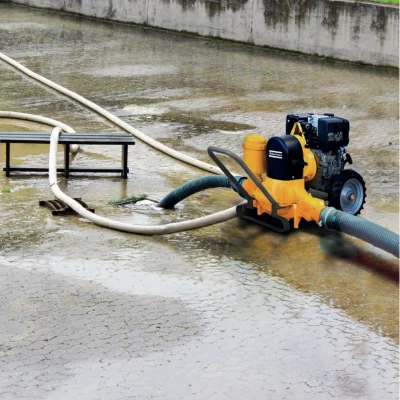Rental of pumps for water drainage
Rental of pumps for water drainage
Why is pump rental the ideal solution for water drainage?
Water removal is one of the most widespread problems in every field, and to solve it effectively, safely and promptly, the ideal solution is to rent drainage pumps.
Pumps, both surface and submersible, are in fact one of the most used machinery in construction, industry and agriculture and serve precisely to move water from one point to another, lending themselves to a very large number of uses and satisfying the needs of various types of businesses and activity.
The CGTE rental fleet offers a wide range of rental pumps specific to every need.
Which pump to use for white water?
For example, the submersible or immersion rental pump such as the WEDA D30N is widely used in the building and construction field to empty flooded areas (such as a room or basement) after heavy rainfall, but also to fill or empty swimming pools or tanks.
The rental of submersible pumps is ideal for works with both white water (those used for cooling industrial plants, those used to clean the outside or those collected from rain) and with untreated black water (those coming from the discharges of domestic sanitary ware, loaded with substances such as detergents, oils, degreasers and detergents produced by kitchens and bathrooms).
Rental submersible pumps are also ideal for solving one of the most widespread needs: withdrawing water from wells and using it subsequently for the most varied uses. In these situations, it is necessary to carefully consider the head (i.e. the height up to which the pump would be able to push the fluid). Submersible pumps with head up to 23 meters are available in the CGTE rental fleet.
Diaphragm pumps for waste water
The rental of diaphragm pumps such as the LB80 is particularly suitable for more difficult uses, such as drainage or use in agriculture.
The main advantages of renting diaphragm pumps compared to submersible pumps are:
Excellent priming and self-priming capacity – Diaphragm pumps can lift fluids from levels lower than the one at which they are located, with the advantage of being able to suck liquids from points below it. Furthermore, a diaphragm pump can be activated without the need to fill the suction pipe (unlike the centrifugal pump), thanks to the ability to suck in the air contained in the suction pipe during the start-up phase and eliminate it through the line delivery (self-priming). After eliminating all the air, the pump primes and operates normally.
Good dry running capability – diaphragm pumps can withstand reasonable periods of dry running (for example: when operating in self-priming mode or in the event of suction line rupture) without adverse consequences and are therefore less likely to suffer damage due to overheating or seizures with respect to centrifugal pumps.
Mechanical and chemical resistance – Not having direct contact with the liquid, the diaphragm pump is the only one that can pump liquids that are not perfectly filtered with residues of solid particles such as crystals, sand, gravel. It can also vacuum most aqueous substances containing acids, solvents, abrasive particles, sediments or sludge.
What accessories or machinery are rented together with the pumps?
To make a rental pump perfect for every application, the CGTE fleet offers rental of extensions for 5 and 10 meter hoses, as well as the rental of generator sets to power electric pumps in places without electricity availability and the rental of trucks for transporting the rental pump directly to the construction site.




